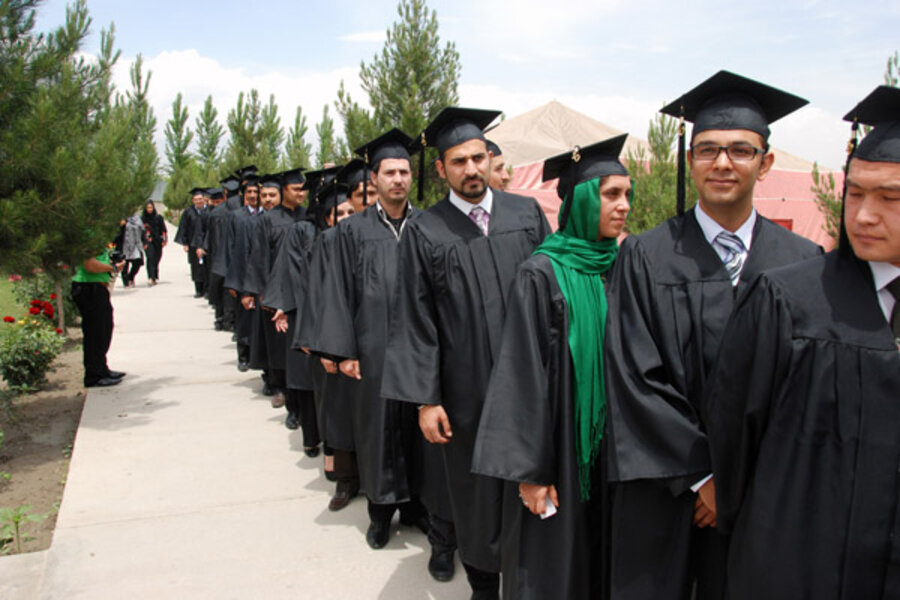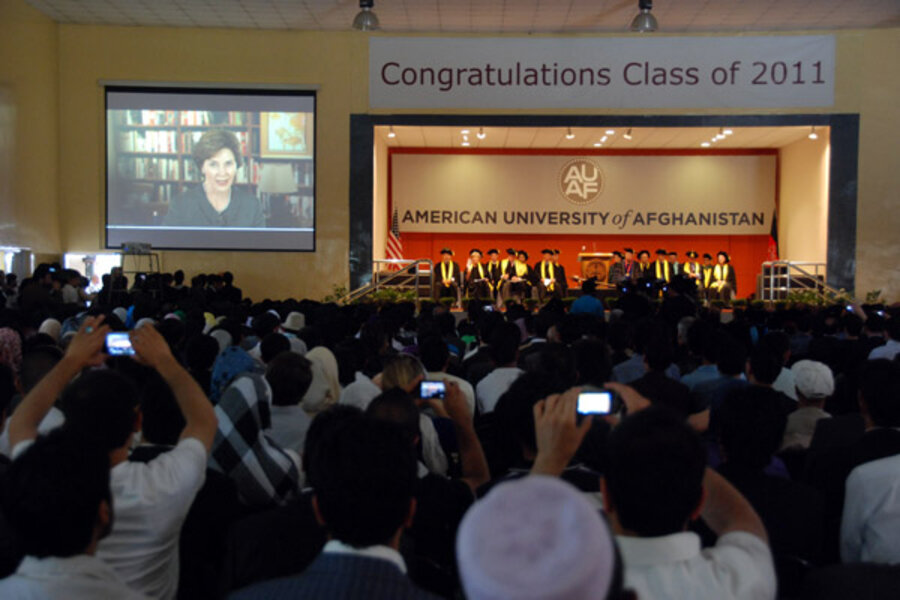Can Afghanistan hang on to its newly minted college grads?
Loading...
| Kabul, Afghanistan
On a well-manicured lawn lined with rose bushes in full bloom – 211, boasts one brochure – members of American University of Afghanistan’s first graduating class mingle and take pictures with former presidential contender Abdullah Abdullah. Though there are just 32 graduates in the first class, most of the university’s 789 students have turned out for the ceremony.
Packed into the auditorium, they are told that Harvard, Stanford, and George Washington University, among other US institutions, have sent letters of congratulations. first lady Michelle Obama also has sent a letter, only to be outdone by former first lady Laura Bush who produced a video message that played on two projectors just ahead of top US Ambassador Karl Eikenberry’s keynote speech.
The flurry of high-level attention to this small graduation Thursday highlights just how big a deal it is in a country battling the effects of decades of brain drain.
“It’s hard for the students to understand it’s not normal to get this level of attention,” whispers one university official as the former first lady’s message plays.
But such focus on the university and its graduates shouldn’t be a surprise. After three decades of war, the country's most talented professionals have fled, leaving behind a nation where 72 percent of the people are now illiterate and the number of universities may not even reach 50.
So, as the first graduating class of the American University of Afghanistan (AUAF) collected their diplomas and shook hands with Ambassador Eikenberry, the most remarkable thing about the moment may have been that the majority of the graduates said they were committed to staying in Afghanistan.
“For a master's degree, yes, it’s tempting to go overseas. But for living, it’s not. Once you’ve got an education, it seems like this is where people need you most,” says Sulieman Hedayat, one of 32 students who graduated on Thursday.
AUAF opened its doors in 2006, and everyone from prominent Afghan businessmen to institutions like USAID have invested tens of millions of dollars in the hopes of minting a university that produces students who can help rebuild Afghanistan.
For the country
In his keynote address, Eikenberry praised the students’ accomplishments but also reminded that they should now reach out and provide guidance such as that they received at AUAF. “I thank you in advance for all you’re going to do for your country,” he told the students.
Investing in the development of people who then flee the country has long been a problem for Afghanistan. Just last week, three Afghan students bolted for Canada at the conclusion of their study abroad in Midwest. Most famously, the Afghan national soccer team had to temporarily disband in 2004 when nine of the players disappeared during training camp in Italy and later turned up as asylum seekers.
For graduates and young people, Afghanistan often holds little promise. Aside from on going security problems, unemployment remains near 35 percent and the average annual income is $800, about a third of what those in neighboring Tajikistan make and less than 10 percent of what the average Iranian makes. With about 80 percent of the country working in agriculture, options remain limited for those with an education.
Until the end of the Russian invasion in the 1980s, the Afghan government helped recent graduates find jobs within the government. When that system dissolved, nepotism became the determining factor for employment, says Habibullah Rafi, a political analyst and member of the Afghan Academy of Sciences.
“There is nothing happening to help graduates after they finish college,” he says. “There is nothing for poor graduates.”
In this environment, it is not uncommon to find people with university degrees working low-level jobs throughout Afghanistan. The problem is particularly pronounced among medical students. With only a limited number of residencies available in Kabul, a number of students are asked to complete their hospital tours in the provinces. Due to safety concerns many refuse, leaving them unable to complete their degree.
“Overall this is a problem for university graduates – they can’t get their desired job,” says Shafiq Wardak, a communications professor at Kabul University.
The job hunt
Among AUAF's first graduating class, most graduates either had jobs or a master's program lined up after completing their undergraduate degree. Some hold government jobs, some nonprofit, and a few have started their own businesses. Many of the students actually held jobs throughout the course of their studies. And university officials proudly say that several government ministries actively recruit among the student body.
While at least one AUAF student worked as a janitor before starting his studies, others came from prominent families in Afghanistan. At $5,500 per year, the tuition remains an astronomical sum for the average Afghan family, though AUAF provides varying amounts of financial aid to 70 percent of its students.
A number of students say AUAF was worth the investment compared with government or other private universities because it offers a relevant curriculum.
“At AUAF, you can apply what they teach you to your job,” says Lida Nadery, one of AUAF’s first graduates.
Unlike other institutions, it does not face government regulations that often create challenges for universities here. Aside from complaints about outdated teaching methods, public universities must contend with the added challenge that Afghan law forbids public institutions from charging tuition.
“The problem with Afghanistan’s higher education is that the government has a lot of control and there is resistance to reform,” says Sharif Fayez, former minister of higher education and founder of AUAF.






